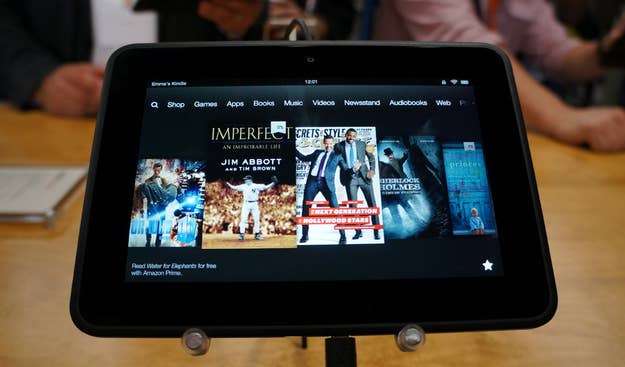
Yesterday in Santa Monica, Amazon unveiled their bigger, stronger, faster versions of the Kindle (now with more White™) and Kindle Fire (super plus HD!). The offerings were solid all around, with modest improvements that will likely push many people who were on the fence about e-readers and tablets to invest in one for themselves or a loved one this holiday season.
But as I was walking around, trying out the new toys, I couldn’t help but think about a line I heard in one of the promotional videos Amazon played. “This is exactly what Stark Trek promised me would happen,” a man said shortly after picking up the new Kindle Paperwhite. The device is indeed pretty wonderful, with a new, much requested, backlight and incremental spec improvements (though I couldn’t tell the difference in resolution with my naked eye).
Frankly, I think the most revolutionary thing about the new line of Kindles is the price. A $69 introductory Kindle is kind of incredible, considering it was $400 just five years ago, and I wouldn’t be surprised to see something like a $5 Kindle within a few years — despite Bezos's denials, Amazon's model is indeed giving away the razor and charging for the blades. But is it really the tablet we were promised in so many sci-fi movies and high-tech concept videos of yesteryear?
View this video on YouTube
Knight Ridder’s “The Tablet Newspaper: A Vision of the Future” (1994)
This concept video is filled with equal parts visionary tabletry and hilarious anachronism. When I first discovered this 1994 video back in 2007, the iPad hadn’t yet been released, and I’m incredibly glad I didn’t ramble on about my skepticism that any company would ever make a tablet work.
“Well, I do believe for the first time we’re going to be seeing an alternative to ink on paper. It may be difficult to conceptualize the idea of digital paper, but in fact we believe that is what’s going to happen,” Knight-Ridder director Roger Fidler promises in the video. “Tablets will be a whole new class of computer. They’ll weigh under two pounds. They’ll be totally portable. They’ll have a clarity of screen display comparable to ink on paper.”
The fun thing about the tablet from the 1993 AT&T concept video “Connections” is that it appears to have a crease, suggesting that maybe tablets of the future will fold up to become more portable.

In the 1994 Sun Microsystems concept video "Starfire," we see how people of the future will be able to control other gadgets remotely — in this case, a camera for a commercial production.
The fact that we don’t yet have some of the tablet features — if only our fragile tablets were bendable — we were promised in the 1990s is no slight to Amazon. In fact, my job would be incredibly boring if all of our dreams of the future had been realized. But I just can’t help myself from putting each new gadget into some kind of historical context — how will the people of 50 years in the future look at our current gadgets, and what did the people of 50 years ago want out of their entertainment machines? The first question about people of the future is much harder to answer, but I think we can find clues from the answers to the second question.
So what was the hot new toy of 50 years ago? Color TV.
Flip through the newspapers and magazines of 1962 and you’ll find gorgeous ads for the latest hot new gadget, color television. The Jetsons debuted that September and Walt Disney’s Wonderful World of Color was entering its second year. But that year just three percent of U.S. homes had a color TV. It would take another decade before 50 percent of American households would have color TV.
It'll be a decade of the Kindle in five years, and it seems likely that tablets and e-readers will reach 50 percent of homes long before then, as prices plummet toward nothing. There's a funny relationship between ubiquity and that feeling of "the future," though — when everybody's holding a tablet, how many will fondly remember that they're holding the promise of Star Trek in their hands?
Matt Novak writes the Paleofuture blog for Smithsonian magazine, The Paleofuturist column for the BBC, and the Retrofuturism column for The Daily. He also writes about old inventions for Pacific Standard. He tweets here.

